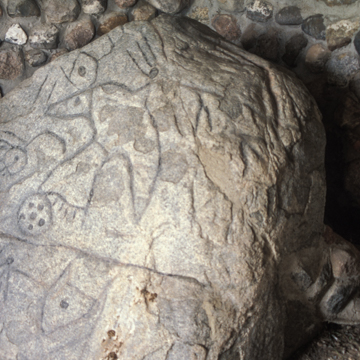Writing Rock State Park preserves an intriguing artifact from prehistoric Native American traditions that predates even oral history traditions of any current Native American group. Two granite boulders are incised with thunderbird figures. Comparable sacred rock art sites are found at only a few archaeological sites on the northern Great Plains, for example in Saskatchewan, Alberta, and Wyoming. As interpreted by modern-day archaeology, thunderbirds are mythological figures associated with lightning and thunder in traditions of the Algonquian and Siouan-speaking people, including the Plains Cree, Plains Ojibwe, Gros Ventre, Crow, Dakota (Sioux), Mandan, and Hidatsa. In 1936, concern over potential vandalism motivated the State Historical Society to acquire the site. In 1956, a fieldstone kiosk was constructed to shelter and enclose the stone. As intriguing as the unexplained petroglyphs, the site of this object is equally dramatic, leading visitors along subtly ascending graveled roadways to a powerfully sublime landscape setting positioned high above all surrounding vistas. Clearly this place was understood as a site of sacred meaning and of such power and presence as to be unmistakable to present-day visitors.
You are here
Writing Rock State Historic Site
If SAH Archipedia has been useful to you, please consider supporting it.
SAH Archipedia tells the story of the United States through its buildings, landscapes, and cities. This freely available resource empowers the public with authoritative knowledge that deepens their understanding and appreciation of the built environment. But the Society of Architectural Historians, which created SAH Archipedia with University of Virginia Press, needs your support to maintain the high-caliber research, writing, photography, cartography, editing, design, and programming that make SAH Archipedia a trusted online resource available to all who value the history of place, heritage tourism, and learning.


